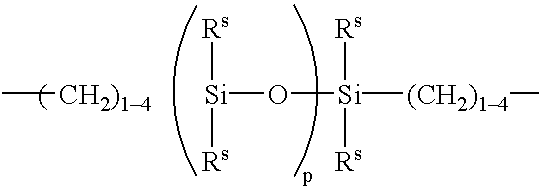Hydrogel from polysiloxane-containing urethane prepolymer, tris (trimethylsiloxy) silylpropyl methacrylate, and a hydrophilic comonomer
a polysiloxane-containing urethane and hydrogel technology, applied in the field of prepolymers, can solve problems such as limiting application
- Summary
- Abstract
- Description
- Claims
- Application Information
AI Technical Summary
Benefits of technology
Problems solved by technology
Method used
Image
Examples
example 1
Synthesis of Hard-Soft-Hard Prepolymer Based on Toluene-2,4-Diisocyanate
2 mole equivalents of toluene-2,4-diisocyanate (TDI) were dissolved in toluene with one mole equivalent hydrogenated bisphenol A (HBPA) in a resin kettle with constant stirring under nitrogen. This STAGE A reaction was run at 60-90° C. for 2-3 hours in the presence of 0.5 wt % “DABCO” catalyst.
One mole equivalent of polypropylene glycol with a molecular weight of about 1000 was then slowly added to the reaction mixture and reacted for 2-3 hours at 60-80° C. under nitrogen.
Excess 2-hydroxyethyl methacrylate (HEMA) was added to the isocyanate terminated STAGE B reaction mixture and then reacted to completion.
Variations of the above synthesis were run by substituting neopentylglycol (NPG) for the hydrogenated Bisphenol A, and by substituting various molecular weight polypropylene glycols for the PPG-1000.
The resulting prepolymers were homopolymerized between treated glass plates in the presence of a free radical ca...
example 2
Hard-Soft-Hard Prepolymer using Isophorone Diisocyanate (IPDI)
The same basic synthetic procedure as described in the previous example was employed except that, due to the decreased reactivity of isophorone diisocyanate relative to toluene diisocyanate, higher levels of reaction catalyst were used. Reaction conditions and summary of the cured homopolymer films is reported in TABLE 2.
Once again, the oxygen permeability of the cured prepolymer increased with increasing molecular weight of the polypropylene glycol polymer. These prepolymers did not produce yellowed films as the TDI materials did upon hydrolytic testing.
TABLE 1CatalystCompositionRX TempSolvent(Dabco)O2 Permeability (DK)TD1-NPG-PPG-1000-HEMA45methyleneA = 02chlorideB, C = 0.05 wt %TD1-NPG-PPG-2000-HEMA45methyleneA = 09chloride / B, C = 0.052 tolueneTD1-NPG-PPG-3000-HEMA45tolueneA = 020B, C = 0.05TD1-NPG-PPG-4000-HEMA452 toluene / A = 0301 methyleneB, C = 0.05chlorideTD1-HBPA-PPG-1000-HEMAA1B = 75toluene / A = 02C = 60methyleneB...
example 3
4,4-Di-Cyclohexyl Methane Diisocyanate Based Hard-Soft-Hard Prepolymers
Hard-soft-hard prepolymers were synthesized per the examples supra except that H12-MDI was used. Films were cured from 30°% prepolymer solution in toluene as reported in TABLE 3.
In general, the H12-MDI prepolymers produced films with greater tear strengths than the TDI or IPDI diisocyanate based systems and were slightly less oxygen permeable.
PUM
| Property | Measurement | Unit |
|---|---|---|
| weight percent | aaaaa | aaaaa |
| weight percent | aaaaa | aaaaa |
| hydrophilic | aaaaa | aaaaa |
Abstract
Description
Claims
Application Information
 Login to View More
Login to View More - R&D
- Intellectual Property
- Life Sciences
- Materials
- Tech Scout
- Unparalleled Data Quality
- Higher Quality Content
- 60% Fewer Hallucinations
Browse by: Latest US Patents, China's latest patents, Technical Efficacy Thesaurus, Application Domain, Technology Topic, Popular Technical Reports.
© 2025 PatSnap. All rights reserved.Legal|Privacy policy|Modern Slavery Act Transparency Statement|Sitemap|About US| Contact US: help@patsnap.com



